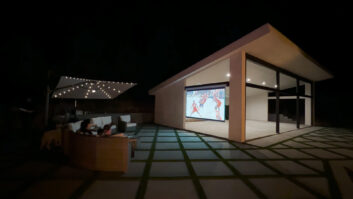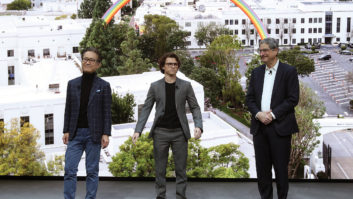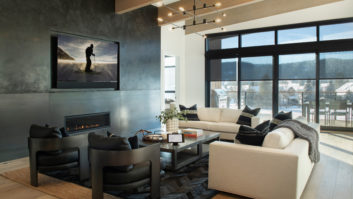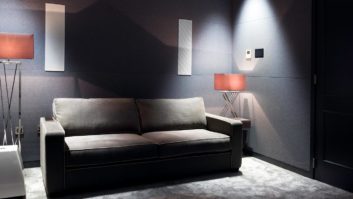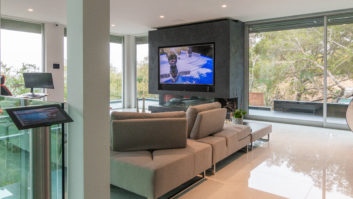The personal video recorder is one of the most successful and frequently used components of audio/video gear that we install in our clients homes. In fact, most of our clients have several recordersone in the main family room and one in a home theater area and/or master bedroom. These personal video recorders allow our busy clients to watch their favorite shows when they want to watch them and anywhere in the home where we have installed these recorders. But what if they want to watch these home-recorded shows away from their home, lets say from their laptop in the comfort of a hotel room with a high-speed Internet connection?
Such a solution is now possible thanks to a series of technical innovations in the streaming of MPEG4 compressed video. Sony, with its product called LocationFree (www.sony.com/locationfree) and SlingMedia (www.slingmedia.com) (www.slingmedia.com have introduced products this year that are capable of encoding and compressing the audio/video signals coming from the back of a standard-definition personal video recorder and stream them to the homes router. From there they can be received by a Windows PC client attached anywhere in the world on an Internet broadband connection.
The products work like this: Your client has just checked into her hotel room with high-speed Internet access. She connects her laptop computer to the Internet, checks e-mail, and then decides to watch the 60 Minutes episode recorded at home. With the Sony product (for example) she launches a software application called LocationFree. The LocationFree software asks her if she is home or away (the laptop could also be used to capture the streaming 60 Minutes video stream at home). Clicking on the away mode starts the process of connecting the laptop to the clients home router via a DDNS service that Sony provides. This DDNS service ensures that the client can always find and connect to her home router even if her home Internet service provider dynamically changes the IP address of the home router.
Once the router connection is established, the video stream from the homes personal recorder starts to play in a window that opens on the laptop. Your client can even control the video recorder because the client software has IR codes built into the software that emulate the IR codes of the personal video recorder remote. Clicking on the guide button on the laptop screen issues an IR command sent from the hotel room laptop to their home router and then from the router to the Sony LocationFree BaseStation where the IR code is blasted to the personal video recorder to show the guide. Very cool!
Now for a real-life example: I was at my sons soccer tournament last month and between games I drove my car with my wireless laptop around the local neighborhood looking for someones unprotected wireless access point (this took about a minute!) Once connected to the Internet I launched my Sony LocationFree software and I was able to watch a Davis Cup tennis match on my laptop that I had recorded at home. With a hotdog in one hand and my Davis Cup tennis match playing on my laptop in the other hand, I was in my element. And this kind of video streaming is just the beginning. What if I could see this Davis Cup match on my web-connected cell phone, PDA, or even my sons Sony Playstation Portable?
Marrying the convenience of personal video recording with the flexibility of watching your content anywhere in the world is a very appealing technology. Both the Sony LocationFree and the SlingMedia products allow you to do this but before you run off and sell these products to all of your clients you should be aware of the following limitations:
Your client must have a broadband upload bandwidth of at least 300Kbps from their home. This is the minimum bandwidth requirement to upload video from the home to the remote laptop. When the available bandwidth falls below this level the video transmission becomes unacceptably poor or doesnt work at all. You can check your clients upload speed by using speed tools found on a number of websites ( like www.dslreports.com). The important concept to understand here is that, in the future, the upload speed of residential high-speed Internet access may become as important as download speed. Currently we live in a world most of the digital content we want to have inside our home is located outside the home so download speeds are a priority. Soon, we will want the content that we have inside our home to be available to us anywhere we are and that will place a much higher priority on upload speeds. For this reason, if your client can afford it (and if its available), I recommend high-speed residential broadband synchronous services.
Both the SlingMedia and Sony solutions can only be used on standard-definition personal video recorders, not high-definition video recorders. There are two reasons for thisone is the technical difficulty of streaming high-definition video over a limiting 300Kbps pipe and the other is the potential legal issues involved in the capture and distribution of high-definition content over an Ethernet backbone.
Only one laptop can access your media content at a time. You can purchase multiple client licenses but the streaming video is limited to one client device at a time.
If you take over the control of the home personal video recorder from your hotel room you should make sure that no one at your home is watching that video recorder at the same time, unless they want to watch what you are watching.
Place shifting of personal video recording is just emerging as a very exciting new product category. To be honest, these new products are still in their infancy and these first-generation products dont always have the image quality and low latency that we would prefer for audio/video enjoyment and control. But over the next few years we will continue to see better audio/video compression algorithms, better encoding and decoding chipsets and faster Internet bandwidth offerings. Its only a matter of time before placeshifting of personal video recordings becomes as popular as the time-shifting feature is today.
Gordon van Zuiden ([email protected]) is president of cyberManor, in Los Gatos, California.
